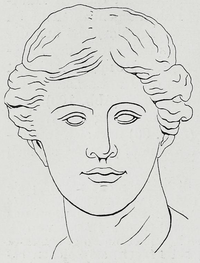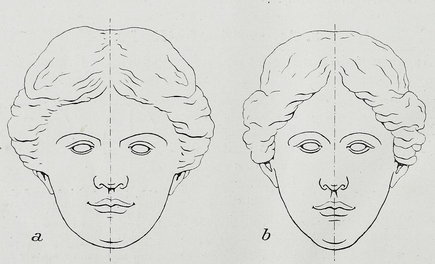Facial symmetry


Facial symmetry is one specific measure of bodily asymmetry. Along with traits such as averageness and youthfulness it influences judgements of aesthetic traits of physical attractiveness and beauty.[1] For instance, in mate selection, people have been shown to have a preference of symmetry.[2][3] This is due to the fact that it is seen an indicator of health and genetic fitness,[3] but also as holding adaptation qualities; reflecting the ability to withstand the changes in their environments.[4]
Facial symmetry has been suggested as a possible physical manifestation of the 'big-five' personality traits.[5] For example, it is found that extraversion and openness are strongly associated with the symmetry of the face.[5] Hormones such as testosterone and estrogen are believed to be associated with developmental processes and growth of facial features during puberty and as a result are hypothesized to be the cause for individual differences in the implications associated with facial symmetry.[6]
Facial bilateral symmetry is measured via fluctuating asymmetry of the face comparing random differences in facial features of the two sides of the face that develop and accumulate throughout one's lifetime as a result of stressors.[7][8]
Facial symmetry
Facial symmetry has been shown to have an effect of ratings of attractiveness in human faces.[1][3] More symmetrical faces are perceived as more attractive in both males and females, although facial symmetry plays a larger role in judgments of attractiveness concerning female faces.[9] A wide variety of methods has been used to examine the claim that facial symmetry plays a role in judgments of beauty.
Blending of multiple faces to create a composite[1] and face-half mirroring[10] have been among the techniques used. While studies employing the first method produced results that indicate that more symmetrical faces are perceived as more attractive, studies applying the later method have indicated that humans prefer slight asymmetry. Also studies show that nearly symmetrical faces are considered highly attractive compared to unsymmetrical ones, yet more specifically, people tend to find a face unattractive if a person has an unsymmetrical nose, and effect of unsymmetrical lips do not really affect people on judging attractiveness.
The most conspicuous directional asymmetries are sometimes only temporary.[11] For example, during speech, most people (76%) tend to express greater amplitude of movement on the right side of their mouth. This is most likely caused by the uneven strengths of contralateral neural connections between the left hemisphere of the brain (linguistic localization) and the right side of the face.[12]
Conclusions derived from face mirroring, however, have been called into question, because it has been shown that mirroring face-halves creates artificial features. For example, if the nose of an individual is slightly bent to the right side, then mirroring the right side of the face will lead to an over-sized nose, while mirroring the left side will lead to an unnaturally small nose.[12]
Evolutionary theorists in biology and psychology argue that more symmetric faces are preferred because symmetry is a possible honest sign of superior genetic quality and developmental stability.[1][13] However it is possible that high facial symmetry in an individual is not due to their superior genetics but due to a lack of exposure to stressors during development. This potentially confounding source of facial symmetry is not explored in the literature. The notion that facial symmetry is viewed by humans as an indicator of 'good genes' is supported by experiments demonstrating that more symmetrical faces are rated as healthier than less symmetrical faces.[3][9] For example, evidence has found that ratings of a person’s facial symmetry is positively associated with ratings of healthiness of their facial skin.[14] Additionally, asymmetry can be fluctuated by increasing health challenges during growth. As a result, phenotypic quality and how well an individual's genome can fight disease and uphold normal development can be indicated by symmetry.[12] Furthermore, studies suggest that facial fluctuation asymmetry, non symmetrical faces, may also be associated with an individuals physiological, psychological and emotional distress.[15]
Additionally current studies indicate that face preferences in adults can be predicted by the number of infections in childhood. People who had more infections as children prefer more sex-typical and symmetric faces because those faces indicate being healthy. Especially recent infections trigger this preference. People who had more childhood infections and some recent infections care a lot about sex-typical and symmetric faces.[16]
-

-

Original
-

Facial symmetry is also a valid marker of cognitive aging.[8] Progressive changes occurring throughout life in the soft tissues of the face will cause more prominent facial asymmetry in older faces.[12] Therefore, symmetrical transformation of older faces generally increases their attractiveness while symmetrical transformation in young adults and children will decrease their attractiveness.[12] Males with more symmetric faces in old age have higher intelligence and are more efficient at information processing than males with less symmetric faces. This is possibly due to the better genes leading to more resistance against stressors in life which is then reflected in less accumulated fluctuating asymmetry.[8]
Non-scientific theories of attraction and symmetry abound. Symmetry of each face is evaluated by human brain via the facial recognition process. This fast and effective detection is difficult with computer programs.[17][18] For instance, the faces that were considered to possess a strong aesthetic appeal were the ones where the conjunction of similar or corresponding facial features were, to some extent, contrasting.[19] Likewise shared features echoism, proportions and similarity to people the person bonded to early in life (prima copulism) have been suggested as relevant.[20]
Relationship to personality
Research indicates that facial symmetry is linked to the 'big-five' model of personality. The most consistent finding is that facial symmetry is positively correlated with extraversion, indicating that individuals with more symmetric faces are also more extroverted.[5][21][22] More symmetrical faces are also judged to be lower on neuroticism but higher on conscientiousness and agreeableness.[23] More symmetrical faces are also more likely to have more desirable social attributes assigned to them, such as sociable, intelligent or lively.[22]
However, the relationship of facial symmetry and the 'big-five' personality model remains somewhat unclear with regard to neuroticism, openness, agreeableness and conscientiousness. While the previously described studies lead to the expectations that more symmetrical faces will be higher on extraversion, openness, agreeableness and conscientiousness, and lower on neuroticism, these expectations were not confirmed empirically. Openness and agreeableness appear to be significantly negatively related to facial symmetry, while neuroticism and conscientiousness do not seem to be linked to facial symmetry. The relationship of facial symmetry and the 'big-five' personality model requires further examination in order to allow for complete conclusions to be drawn.[5]
Recent study shows the association of trustworthiness and with symmetry on the face. People are biologically evolved to detect the deceptive intention of other people by observing the asymmetry in the face. When people are lying, their facial muscles become imbalanced.[24]
Facial averageness vs. symmetry
According to the theory of Sexual Selection, facial symmetry plays a large role in male and female perceived attractiveness. Facial symmetry is considered to be among many other characteristics related to health, beauty and facial and physical attractiveness.[25] However there is dispute of whether increased facial attractiveness is solely due to changes in symmetry or averageness. Experiments show that symmetry and averageness make independent contributions to overall attractiveness. Averageness remains a significant predictor of attractiveness when the effect of symmetry was excluded. The results of these experiments rejected that the attractiveness of facial configurations could be solely due to associated changes in symmetry, and strengthened the evidence that facial averageness is attractive.[26] In addition, research has shown that facial symmetry, coined with averageness, had a positive effect on attractiveness ratings, suggesting these two influences are invariably linked.[27]
See also
References
- 1 2 3 4 Grammer, K., & Thornhill, R. (1994). Human (Homo sapiens) facial attractiveness and sexual selection: the role of symmetry and averageness. Journal of comparative psychology (Washington, D.C. : 1983), 108(3), 233–42.
- ↑ Rhodes, Gillian; Zebrowitz, Leslie A. (2002). Facial Attractiveness: Evolutionary, Cognitive, and Social Perspectives. Ablex. ISBN 1-56750-636-4.
- 1 2 3 4 Jones, B. C., Little, A. C., Tiddeman, B. P., Burt, D. M., & Perrett, D. I. (2001). Facial symmetry and judgements of apparent health Support for a “‘ good genes ’” explanation of the attractiveness – symmetry relationship, 22, 417–429.
- ↑ Fink, B., Neave, N., Manning, J. T., & Grammer, K. (2006). Facial symmetry and judgements of attractiveness, health and personality. Personality and Individual Differences, 41(3), 491-499.
- 1 2 3 4 Fink, B., Neave, N., Manning, J. T., & Grammer, K. (2005). Facial symmetry and the “big-five” personality factors. Personality and Individual Differences, 39(3), 523–529.
- ↑ Gangestad, S., & Thornhill, R. (2003). Facial masculinity and fluctuating asymmetry. Evolution and Human Behavior, 24(4), 231–241.
- ↑ Penton-Voak, I. S., Jones, B. C., Little, a C., Baker, S., Tiddeman, B., Burt, D. M., & Perrett, D. I. (2001). Symmetry, sexual dimorphism in facial proportions and male facial attractiveness. Proceedings. Biological sciences / The Royal Society, 268(1476), 1617–23.
- 1 2 3 Penke, L., Bates, T. C., Gow, A. J., Pattie, A., Starr, J. M., Jones, B. C., Perrett, D. I., et al. (2009). Symmetric faces are a sign of successful cognitive aging. Evolution and Human Behavior, 30(6), 429–437.
- 1 2 Rhodes, G., Proffitt, F., Grady, J. M., & Sumich, A. (1998). "Facial symmetry and the perception of beauty." Psychonomic Bulletin & Review, 5(4), 659–669.
- ↑ Kowner, R. (1996). "Facial asymmetry and attractiveness judgment in developmental perspective." Journal of Experimental Psychology. Human perception and performance, 22(3), 662–75.
- ↑ "Symmetric Shape Deformation Considering Facial Features and Attractiveness Improvement" by Kim Jung-Sik, Shin Il-Kyu, Soo-Mi Choi, Dept. of Computer Science and Engineering, Vol. 16 No. 2 pp. 29–37, Sejong University
- 1 2 3 4 5 Perrett, D. I., Burt, D. M., Penton-Voak, I. S., Lee, K. J., Rowland, D. a, & Edwards, R. (1999). "Symmetry and Human Facial Attractiveness." Evolution and Human Behavior, 20(5), 295–307.
- ↑ Scheib, J. E., Gangestad, S. W., & Thornhill, R. (1999). "Facial attractiveness, symmetry and cues of good genes." Proceedings. Biological sciences / The Royal Society, 266(1431), 1913–17.
- ↑ Jones, B.C.; Little, A.C.; Feinberg, D.R.; Penton-Voak, I.S.; Tiddeman, B.P.; Perrett, D.I. "The relationship between shape symmetry and perceived skin condition in male facial attractiveness". Evolution and Human Behavior. 25 (1): 24–30. doi:10.1016/s1090-5138(03)00080-1.
- ↑ Shackelford, T. K., & Larsen, R. J. (1997). "Facial asymmetry as an indicator of psychological, emotional, and physiological distress." Journal of Personality and Social Psychology, 72(2), 456–466.
- ↑ de Barra, Mícheál; DeBruine, Lisa M.; Jones, Benedict C.; Mahmud, Zahid Hayat; Curtis, Valerie A. (November 2013). "Illness in childhood predicts face preferences in adulthood". Evolution and Human Behavior. 34 (6): 384–389. doi:10.1016/j.evolhumbehav.2013.07.001.
- ↑ Chunyu L, Changshui Z, Fang W, Pingfan Y. "Principle [sic] component analysis based symmetry detection." Acta Electronica Sinica 1999;27(5):25–8.
- ↑ Enquist M, Arak A. "Symmetry, beauty and evolution." Nature 2002;372: 169–72.
- ↑ Witherspoon, Gary (1977). Language and Art in the Navajo Universe. Ann Arbor: University of Michigan Press. p. 198. ISBN 0-472-08966-8.
- ↑ Malin, Suzi (2004). Love at First Sight. DK Adult. ISBN 0-7566-0401-X.
- ↑ Pound, N., Penton-Voak, I. S., & Brown, W. M. (2007). "Facial symmetry is positively associated with self-reported extraversion." Personality and Individual Differences, 43(6), 1572–1582.
- 1 2 Fink, B., Neave, N., Manning, J. T., & Grammer, K. (2006). "Facial symmetry and judgements of attractiveness, health and personality." Personality and Individual Differences, 41(3), 491–499.
- ↑ Noor, F., & Evans, D. C. (2003). "The effect of facial symmetry on perceptions of personality and attractiveness." Journal of Research in Personality, 37(4), 339–347.
- ↑ D W, Bava S, Reis V A. 2003. "Relationship between facial asymmetry and judging trustworthiness in faces". University of California.8(3), 225–232
- ↑ http://www.sciencedaily.com/articles/f/facial_symmetry.htm
- ↑ Byatt, G., Rhodes, G., Sumich, A. Psychological Science (January 1999), 10 (1), pg. 52-58
- ↑ http://psycnet.apa.org/journals/com/108/3/233/ Grammer. K., & Thornhill. R. (1994). Human (homo sapiens) facial attractiveness and sexual selection: the role of symmetry and averageness. Journal of comparative psychology, 108(3), 233.
- Fink, B.; Manning, J. T.; Neave, N.; Grammer, K. (2004). "Second to fourth digit ratio and facial asymmetry". Evolution and Human Behavior. 25 (2): 125–132. doi:10.1016/S1090-5138(03)00084-9.
- Oral diagnosis 402 by Dr.Gihane Gharib Madkour, Lecturer of Oral Medicine, Oral Diagnosis & Periodontology, Cairo University
- Symmetric Shape Deformation Considering Facial Features and Attractiveness Improvement by Kim Jung-Sik, Shin Il-Kyu, Soo-Mi Choi, Dept. of Computer Science and Engineering, Vol.16 No.2 P.29~37 Sejong University
- Chunyu L, Changshui Z, Fang W, Pingfan Y. Principle component analysis based symmetry detection. Acta Electronica Sinica 1999;27(5):25–8.
- Enquist M, Arak A. Symmetry, beauty and evolution. Nature 2002;372: 169–72.
Further reading
- Fink, B.; Grammer, K.; Thornhill, R. (2001). "Human (Homo sapiens) facial attractiveness in relation to skin texture and color". Journal of Comparative Psychology. 115 (1): 92–99. doi:10.1037/0735-7036.115.1.92. PMID 11334223.
- Johnston, V.; Hagel, R.; Franklin, M.; Fink, B.; Grammer, K. (2001). "Male facial attractiveness: evidence for hormone-mediated adaptive design". Evolution and Human Behavior. 22 (4): 251. doi:10.1016/S1090-5138(01)00066-6.
External links
- "Teeth, Beauty, Biology, and Health" – a class handout on dentition and facial symmetry at the College of Dentistry – University of Illinois at Chicago.
- "Symmetry measurement tool" – Symmetry measurement tool
- "Chimeric Face Experiment" – Perform a facial symmetry and attractiveness experiment by uploading a photo
- FaceResearch – Online studies on facial symmetry by researchers affiliated with University of Aberdeen (Scotland) School of Psychology, and University of St. Andrews (Scotland).
- "A facial symmetry plugin for the GIMP"—Try experimenting with facial symmetry, using open source software.
- "" – perfect symmetry